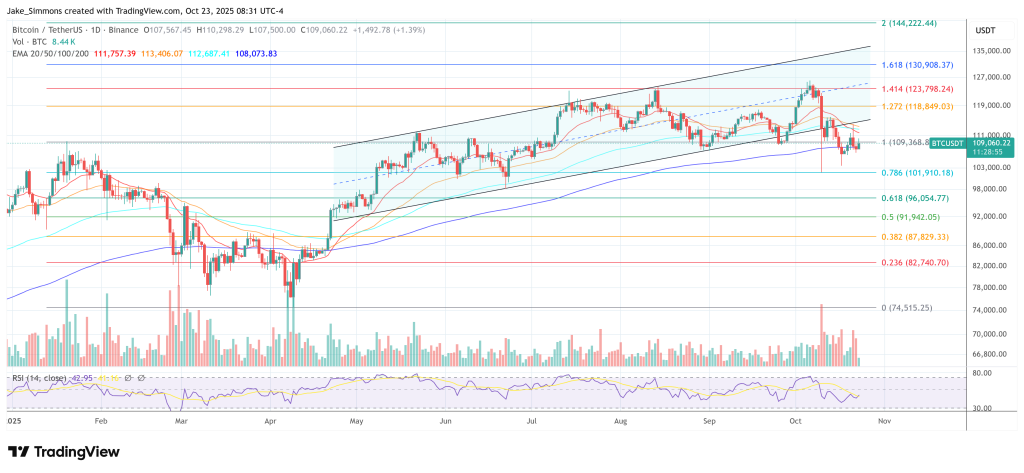In a wide-ranging Coin Tales interview revealed October 21, David Marcus—co-founder and CEO of Lightspark, former president of PayPal and co-creator of Diem, the cryptocurrency challenge initiated by Fb—laid out a thesis that Bitcoin will in the end surpass gold in worth and evolve from a purely “store-of-value” asset into the invisible, impartial settlement layer of the web for cash.
How Bitcoin Might Attain $1.5 Million
“I feel Bitcoin shall be extra precious than gold,” Marcus informed host Natalie Brunell. “At right now’s gold worth, it’s, you understand, $1.3 million a bitcoin that [it] may have a better market cap than gold.” He emphasised he’s “first rate at directional predictions” however “horrible at timing,” framing the trajectory as inevitable over a five-to-ten-year horizon quite than a near-dated name. The implication of outgrowing gold’s market capitalization locations Bitcoin’s potential worth properly north of $1.3 million per coin and, at Gold’s latest ATH at $4,381.58/oz, above $1.53 million.
Marcus’s worth view is inseparable from his broader rivalry that BTC should progress past a slim “digital gold” narrative. Echoing a line from analyst Matt Pines that Brunell cited—“if Bitcoin is simply a retailer of worth, it has failed”—Marcus agreed “totally,” however added a important caveat: the savings-asset section was a essential precondition for utility.
“We imagine that the store-of-value section is totally important for us to have the ability to truly construct a utility section of Bitcoin on prime of it,” he mentioned, arguing that institutional adoption, ETFs and nation-state accumulation conferred sufficient legitimacy to start scaling real-world funds. “Now that each establishment… whether or not it’s BlackRock, Constancy or others, are literally supporting Bitcoin… we are able to truly actually begin constructing cost utility on prime of it.”
That utility imaginative and prescient hinges on utilizing Bitcoin extra like TCP/IP—an invisible settlement substrate—than as a unstable unit of account for on a regular basis spending. Marcus was blunt about behavioral and financial constraints: “Folks don’t need to use Bitcoin for on a regular basis purchases as a result of it’s unstable and folks need to truly profit from appreciation… they don’t need to be the Bitcoin pizza man.”
Lightspark’s method is to maneuver fiat end-to-end whereas utilizing BTC within the center. “You possibly can ship {dollars} from a US checking account to somebody in Mexico receiving Mexican peso… the settlement asset is Bitcoin in between. So you’ve got {dollars}, Bitcoin, Mexican peso and it’s invisible to folks utilizing it.”
Technically, Lightspark is pushing past Lightning’s channel mannequin whereas remaining backward-compatible. Marcus lauded Lightning’s belief mannequin and velocity, however highlighted its liquidity and self-custody frictions when scaled to “billions of endpoints.”
The corporate’s newly launched “Spark” is described as a Lightning-compatible, non-channel cost system that allows spinning up “billions of wallets” with “minimal new belief assumptions.” Crucially, he mentioned, it preserves security valves: “It’s not as trustless as Lightning, however we imagine it’s trustless sufficient and has unilateral exits to Layer 1… you’ll be able to pull a rip twine and nobody can stop you from recovering your funds on L1.”
Stablecoins And Adoption
Marcus additionally argued that stablecoins—regardless of their centralized issuer mannequin—are an unavoidable element of world funds, and that anchoring them to BTC’s settlement layer enhances resilience. He described a private “schizophrenic journey” with stablecoins, disliking the “single throat to choke,” but accepting their ubiquity and making an attempt to reduce belief by avoiding separate gasoline tokens and preserving unilateral exits to Bitcoin L1.
On adoption, Marcus pointed to shifting institutional sentiment. Recounting a panel in New York “put collectively by Citadel Securities,” he mentioned a “majority” of a roughly 450-person room of enormous traditional-finance buyers indicated they personal BTC, versus far fewer holding ETH, stablecoins, or any token. “It is a room that historically would have been very proof against Bitcoin… now the instances have modified so profoundly.” But he nonetheless framed retail penetration as early, estimating “low tons of of hundreds of thousands” of distinctive holders globally and vital headroom from there.
General, Marcus’ thesis returns to first rules: BTC as impartial, scarce, programmable collateral and a credibly decentralized settlement layer. Dismissing critiques that it lacks “intrinsic worth,” he argued, “Underlying shortage of Bitcoin secured by code is the intrinsic worth… that is the one factor that’s deflationary by nature.”
That, he contends, is why Bitcoin ought to outcompete gold over time: “When the primary gold ETFs have been launched, they began mining extra gold. You possibly can’t do this with Bitcoin.” If and when that market-cap crossover arrives, it will validate the structural name embedded in his remarks—and, by extension, the headline-grabbing notion that BTC’s honest worth isn’t just above seven figures, however in the end “extra precious than gold,” which right now maps to $1.5 million.
At press time, BTC traded at $109,060.

Featured picture created with DALL.E, chart from TradingView.com

Editorial Course of for bitcoinist is centered on delivering completely researched, correct, and unbiased content material. We uphold strict sourcing requirements, and every web page undergoes diligent evaluation by our group of prime expertise consultants and seasoned editors. This course of ensures the integrity, relevance, and worth of our content material for our readers.







